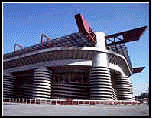![]()
SITES OF MILAN
|
THE SAN SIRO The
San Siro stadium is named after the saint in whose honour a small local
church was dedicated. It was a gift from Piero Pirelli (AC Milan's club
president from 1909-1929) to his beloved city of Milan. The original San Siro was a
typically English construction consisting of four grandstands with a
maximum capacity of 35,000 spectators. 10,000 quintals of cement, 3,500
cubic metres of sand and 1,500 quintals of iron rods were used to build
the stadium. 80 kilogrammes of chalk were used to mark out the pitch. The first match played in the new
stadium was a friendly against none other than local rivals Inter on
September 19th 1926; it finished 6-3 to the visitors. The stadium hosted
its first championship game on October 6th with Milan again losing (2-1
to Sampierdarenese) and its first international was held on February 20,
1927 when Italy drew 2-2 with Czechoslovakia. The San Siro was home
solely to Milan until the end of 1945; Inter played their home games at
the "Arena Napoleonica." Football's very own
"Scala" has had its fair share of refurbishments on the road
to becoming the impressive structure it is today. The major changes took
place between 1938 and 1939 with an increase in the capacity to 50,000
spectators, between 1954 and 1956 with the construction of the second
tier and most recently in 1990 when a third tier was added. In 1935 Milan bought the ground from
the local council and three years later decided to enlarge it. Football
was becoming a big spectator sport and the San Siro needed to increase
its capacity. The development project was overseen by architect Rocca
and chief engineer Calzolari. Utilising the same supporting structure a
system of fitted steps were built with flights leading up with entry
from outside. The capacity was originally 150,000,
but the city council issued a decree reducing it to 100,000 in 1952.The
re-modernised stadium was officially opened on May 31, 1939 when Italy
played out a 2-2 draw with England. Gate receipts were 1.2 million lira.
Work on the new ground finished in 1939 at a cost of 5.1 million lira. The second phase of expansion began
in 1954 and officially finished twelve months later on October 26, 1955,
raising the capacity to 85,000. Floodlights were installed for the first
time in 1957 and ten years later an electronic scoreboard was added. In
1979 the floodlights were replaced with more modern ones and the second
tier was repaired. On March 3, 1980 a stone at the
entrance to the ground was engraved with the name Giuseppe Meazza, one
of Inter's greats, who had died the previous year. In 1986 the first
tier was filled with numbered and colour-coded seats: red in the main
stand, orange in the opposite stand, green behind the north goal and
blue where the Milan hardcore fans gathered. The latest phase of modernisation
took place for the World Cup in 1990. The third tier was erected after
many months of hard work; the official opening took place on April 25,
1990. Eleven outside towers (inside were flights of steps leading up to
the next level) held the weight of the top tier and the framework of the
roof. The roof was covered with translucent polycarbonate panels. The
second and third tiers were also filled with numbered and colour-coded
seats. The pitch dimensions are 105 metres
long by 68 metres wide and the stadium is situated near the racecourse,
around 6 kilometres from the centre of Milan. The San Siro is a symbol of Milan
just as the Scala and Duomo are, but it draws its world fame not only
from football as it has hosted a wide range of events throughout its
history. There was the World Junior
Welterweight title re-match between Duilio Loi and Carlos Ortis on
September 1, 1960 which drew a crowd of 53,043, of which 8,000 were
ringside. The stadium was floodlit with the ring set up in the middle of
the pitch. The gate receipts were 130 million lira. The Italian won the
bout. The stadium has also played host to
a series of "historical" concerts. Bob Marley played his one
and only Italian concert on a stage at the north end of the ground on
June 27, 1980. The chance to see the Jamaican singer live drew a crowd
of 90,000 - similar to that of a derby game. There was the same rush for
tickets when Bruce Springsteen played there in 1985. Three years ago, the main stand hosted an outdoor summer disco. Today, there is a museum behind the south stand (curva sud) that looks back over the history of both Milan and Inter, housing mementoes and souvenirs of personalities that have helped write the stadium's rich history. |
|


